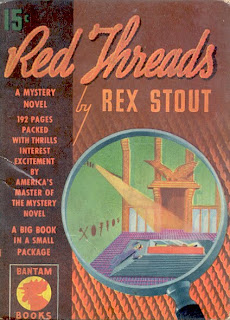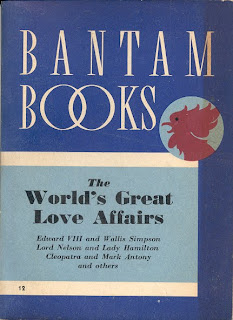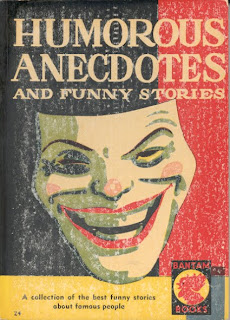skip to main |
skip to sidebar
The 9th book published by Bantam Publications is Enter the G-Men by William Engle. The book is subtitled "Johnny Barton Pitted Against 'Monk the Fiend'". Engle published three G-Men novels in the 1930s, one under Engle and two as Laurence Dwight Smith. This is a paperback original.
In common with all but one of LA Bantam's books Enter the G-Men is 100 pages long and is 110 mm (4 5/16") wide by 152 mm (6") tall. Cover and pages are made from high acid pulp paper. The page collation is:
[1] title page,
2-100 Enter the G-Men.
The title page has the copyright date - 1940.
In common with most LA Bantams there are variant covers. The three I know of are strong yellowish green/light orange yellow, strong yellowish green/light yellowish green and strong blue/light orange yellow.
In the posts about individual Bantam Publication books I've used the phrase "in common with all but one of LA Bantam's books [book x] is 100 pages long." Here is the exception.
Red Threads by Rex Stout is 192 pages long. It is also unique in other ways. While other Bantams sold for 10 cents, Red Threads sold for 15 cents. Unlike the other Bantam books with illustrated covers (numbers 21-28) there is no text version of the cover. It is the only Bantam with a blurb about the book on the back cover rather than an ad and with a published date - 1941.
Red Threads is numbered A1 on the spine. It may have been planned as the first of a series of larger, more expensive, illustrated cover only books. But if so it is the only one published before Bantam Publications folded.
Red Threads was first published in The Mystery Book (New York: Farrar & Rinehart, 1939) as the fifth of five stories by five authors and was published separately by Wm. Collins & Sons (London: 1941). The Bantam edition is abridged.
The book is the same size, 110 mm (4 5/16") wide by 152 mm (6") tall, but is better made than other Bantams. Page collation:
[1] title page
[2] copyright page
3-192 Red Threads
Bantam A1
Bantam A1 back
With one exception the 29 books published by Bantam Publications of Los Angeles do not have dates when they were published. The only dates are copyright dates. All of the books, but one, have either a 1940 copyright or the copyright date of the original material. The exceptions are Red Threads (A1) which has the only published date, 1941, and Nobody Heard the Shot (25) with two copyright dates, 1940 and 1941.
External evidence for dates are copyright entries in the Library of Congress Catalogue of Copyright Entries. There are thirteen 1940 entries and four 1941 entries for Bantam paperback originals. The other external evidence is the 21 listings in Publisher's Weekly which are, with one exception, April 1941. See this earlier post for more.
The conclusion is that the books were published in 1940 and 1941. In another post I'll see if the likely year for each book can be teased out of this information.
Early Bantam references from 1981 to 1983 have a wide range of years:
"in 1940", Putting Dell on the Map by William H. Lyles, p. 6,
'between 1939 and 1943", Paperbacks, U.S.A. by Piet Schreuders, p. 59,
"late 1930's", Undercover by Thomas L. Bonn, p. 123,
"debut in 1940 and terminating in 1942", Mass Market Publishing in America by Allen Billy Crider (ed.), p. 167.
Dates from 1939 to 1945 continue to show up in dealer descriptions of the books. No specific images to go with post so I'll put up some of the Bantam books.
Bantam 2
Bantam 12
Bantam 14
Bantam 24
In recent posts I've been talking about a couple of subjects in relation to LA Bantam - 10 cent paperbacks and the selling of books through venders (industry term for vending machines). Here I'll combine them.
The Little Blue Books discussed here sold for 10 cents (and later 5 cents and even 2 1/2 cents on special). The attempt to sell through venders obviously didn't work but hundreds of millions did sell by mail order. This method of selling partially explains how the publisher made money at 10 cents - cutting out the middleman. The other obvious way was a very low unit cost. The books were small (stapled, 3 1/2" x 5", 64 pages), looked cheap and produced in the millions. A terrific resource on these books is an article by Richard Colles Johnson and G. Thomas Tanselle, "The Haldeman-Julius 'Little Blue Books' as a Bibliographical Problem", in The Papers of the Bibliographical Society of America.
Here are two examples of the Little Blue Books sold in venders plus a regular edition of A Voyage to the Moon. Both copies of A Voyage to the Moon have a different series name on the title page than on the wrapper - Pocket Series and Little Blue Book respectively. Pocket Series was the series name before Little Blue Books. The first printing of this book dates from Oct-Nov 1923. These copies are later issues (because of the change in series name on the wrapper) and are almost certainly later printings as the print quality is poor.












